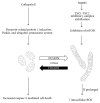The Role of Mitochondria and Oxidative/Antioxidative Imbalance in Pathobiology of Chronic Obstructive Pulmonary Disease
- PMID: 28105251
- PMCID: PMC5220474
- DOI: 10.1155/2016/7808576
The Role of Mitochondria and Oxidative/Antioxidative Imbalance in Pathobiology of Chronic Obstructive Pulmonary Disease
Abstract
Chronic obstructive pulmonary disease (COPD) is a common preventable and treatable disease, characterized by persistent airflow limitation that is usually progressive and associated with an enhanced chronic inflammatory response in the airways and the lung to noxious particles or gases. The major risk factor of COPD, which has been proven in many studies, is the exposure to cigarette smoke. However, it is 15-20% of all smokers who develop COPD. This is why we should recognize the pathobiology of COPD as involving a complex interaction between several factors, including genetic vulnerability. Oxidant-antioxidant imbalance is recognized as one of the significant factors in COPD pathogenesis. Numerous exogenous and endogenous sources of ROS are present in pathobiology of COPD. One of endogenous sources of ROS is mitochondria. Although leakage of electrons from electron transport chain and forming of ROS are the effect of physiological functioning of mitochondria, there are various intra- and extracellular factors which may increase this amount and significantly contribute to oxidative-antioxidative imbalance. With the coexistence with impaired antioxidant defence, all these issues lead to oxidative and carbonyl stress. Both of these states play a significant role in pathobiology of COPD and may account for development of major comorbidities of this disease.
Conflict of interest statement
The authors declare no conflict of interests.
Figures



Similar articles
-
Current concepts on oxidative/carbonyl stress, inflammation and epigenetics in pathogenesis of chronic obstructive pulmonary disease.Toxicol Appl Pharmacol. 2011 Jul 15;254(2):72-85. doi: 10.1016/j.taap.2009.10.022. Epub 2011 Feb 4. Toxicol Appl Pharmacol. 2011. PMID: 21296096 Free PMC article. Review.
-
COPD: balancing oxidants and antioxidants.Int J Chron Obstruct Pulmon Dis. 2015 Feb 2;10:261-76. doi: 10.2147/COPD.S42414. eCollection 2015. Int J Chron Obstruct Pulmon Dis. 2015. PMID: 25673984 Free PMC article. Review.
-
Mitochondrial alterations during oxidative stress in chronic obstructive pulmonary disease.Int J Chron Obstruct Pulmon Dis. 2017 Apr 13;12:1153-1162. doi: 10.2147/COPD.S130168. eCollection 2017. Int J Chron Obstruct Pulmon Dis. 2017. PMID: 28458526 Free PMC article. Review.
-
Update in chronic obstructive pulmonary disease: role of antioxidant and metabolizing gene polymorphisms.Exp Lung Res. 2011 Aug;37(6):364-75. doi: 10.3109/01902148.2011.580416. Epub 2011 Jul 1. Exp Lung Res. 2011. PMID: 21721950 Review.
-
Comparison of oxidant/antioxidant balance in COPD and non-COPD smokers.Heart Lung. 2019 Nov-Dec;48(6):566-569. doi: 10.1016/j.hrtlng.2019.07.005. Epub 2019 Jul 29. Heart Lung. 2019. PMID: 31371032
Cited by
-
Oxidative Stress in Ozone-Induced Chronic Lung Inflammation and Emphysema: A Facet of Chronic Obstructive Pulmonary Disease.Front Immunol. 2020 Sep 2;11:1957. doi: 10.3389/fimmu.2020.01957. eCollection 2020. Front Immunol. 2020. PMID: 32983127 Free PMC article. Review.
-
Gene expression profile of human lung in a relatively early stage of COPD with emphysema.Int J Chron Obstruct Pulmon Dis. 2018 Aug 28;13:2643-2655. doi: 10.2147/COPD.S166812. eCollection 2018. Int J Chron Obstruct Pulmon Dis. 2018. PMID: 30214182 Free PMC article.
-
Effect of Oxidative Stress on Diaphragm Dysfunction and Exercise Intervention in Chronic Obstructive Pulmonary Disease.Front Physiol. 2021 Jun 7;12:684453. doi: 10.3389/fphys.2021.684453. eCollection 2021. Front Physiol. 2021. PMID: 34163375 Free PMC article. Review.
-
Comparative transcriptome analysis of sesquiterpene biosynthesis and functional characterization of sesquiterpene synthases in Leonurus sibiricus L.Planta. 2021 Feb 18;253(3):71. doi: 10.1007/s00425-021-03586-4. Planta. 2021. PMID: 33604817
-
Reactive Oxygen Species Emissions from Supra- and Sub-Ohm Electronic Cigarettes.J Anal Toxicol. 2019 Jan 1;43(1):45-50. doi: 10.1093/jat/bky065. J Anal Toxicol. 2019. PMID: 30192935 Free PMC article.
References
-
- Global Initiative for Chronic Obstructive Pulmonary Disease. Global Strategy for the diagnosis, management, and prevention of Chronic Obstructive Pulmonary Disease. http://goldcopd.org/global-strategy-diagnosis-management-prevention-copd... - PubMed
-
- Burden of COPD. Chronic respiratory diseases. http://www.who.int/respiratory/copd/burden/en.
-
- Bartal M. COPD and tobacco smoke. Monaldi archives for chest disease. 2005;63:213–225. - PubMed
Publication types
MeSH terms
Substances
LinkOut - more resources
Full Text Sources
Other Literature Sources
Medical

